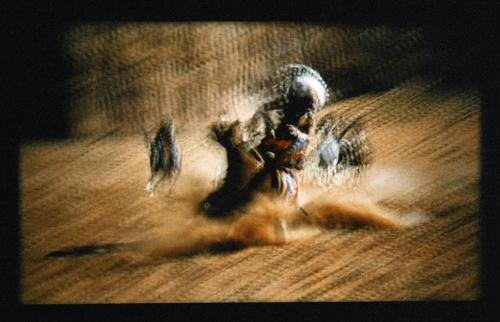Commonplaces II
dal 1/3/2004 al 27/3/2004
Segnalato da
1/3/2004
Commonplaces II
The Blue Gallery, London
An ideal landscape. Victor Pimstein's first body of work to be shown in the UK was Commonplaces, a series of landscapes appropriated from a variety of stereotypes within the genre from the serene landscapes of Claude, the landscape motifs in blue and white ceramics (Sevre or Delft), the images of idyllic beaches, which we all send on holiday postcards, and the deserts and mountains which conventionally serve as the background to Western films.

An ideal landscape
by
Victor Pimstein
Victor Pimstein's first body of work to be shown in the UK was Commonplaces,
a series of landscapes appropriated from a variety of stereotypes within the
genre from the serene landscapes of Claude, the landscape motifs in blue and
white ceramics (Sevre or Delft), the images of idyllic beaches, which we all
send on holiday postcards, and the deserts and mountains which conventionally
serve as the background to Western films. These themes share the fact of being
visual structures, which, according to the artist, we too all share. Moreover,
irrespective of whether they originated in high or low culture, Pimstein
perceived within each with three unifying characteristics: first that of being
"mental" landscapes, secondly of being standardized landscapes and thirdly that
of being idealized landscapes. He himself saw this approach as more cathartic
than strictly analytical: I am a non-religious Jew who was born in Chile and
holds a Mexican passport, educated in the U.S., am married to a Catholic
Italian, adopted a child in Russia, reside in Catalan-speaking Spain, but
consider
English to be my main language. I live an acute struggle to define my identity
in relationship to people and places. One critic called it a superb lesson
in painting and the exhibition sold out.
Now after an acclaimed residency at the Galeria Joan Prats in Barcelona, the
Blue Gallery is the venue for another rather more specific meditation on this
theme, An ideal landscape, although this time the medium is photographic. In
the course of his preparation of the Commonplaces show, Pimstein resorted to
shooting the cinema screen from the projection booth, during performances of
John Ford's westerns, in particular The Searchers. Given the speed of the
projection, the arrested images preserve the movement of the figures (cowboys,
Indians, carriages and horses) just as they eschew narrative, infer familiarity
while occupying that borderline between abstraction and representation. The
element of desert landscape - and here that entails the monumentality of the
American west - is heightened to the point of heroic myth, while nevertheless
rooted in the artist's attempts to define my personal landscape, the boundaries
of
my identity.
A catalogue is available with essays by the painter and by the curator and
critic, Fernando Castro Flórez.
March 3rd - 27th 2004 (Private View March 2nd 6.00-8.30pm)
For further information and/or visual material,
please contact Giles Baker-Smith or Philip Godsal
on 020 7490 3833.
The gallery is open
Monday - Friday 10am - 6pm
Saturday 12pm - 4pm
Tube: Farringdon, Barbican
The Blue Gallery
15 Great Sutton Street
London EC1V 0BX
T +44 (0)20 7490 3833
F +44 (0)20 7490 5749



